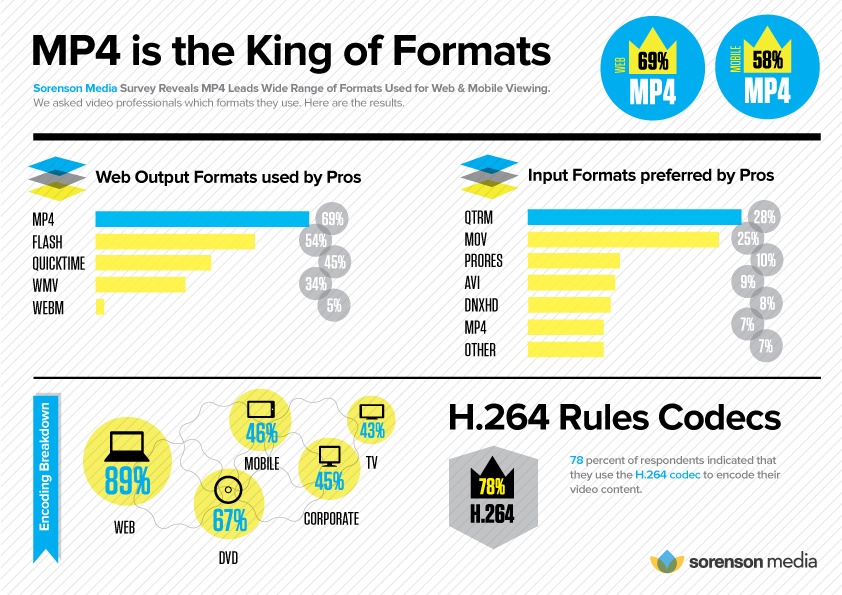![]() Sorenson Media announced a survey it conducted suggests that most of its professional customers use MP4 to distribute video on the web and mobile devices.
Sorenson Media announced a survey it conducted suggests that most of its professional customers use MP4 to distribute video on the web and mobile devices.
For more information visit: www.sorensonmedia.com
Unedited press release follows:
Sorenson Media Survey Reveals MP4 Leads Wide Range of Formats Used for Web and Mobile Viewing, Increasingly Hands-On Role of Video Professionals Worldwide
• 69 Percent and 58 Percent of Respondents Use MP4 as an End Video Format for the Web and Mobile Devices, Respectively; Others Showing Strong Support among Video Pros Include Flash, QuickTime and Windows Media
• QuickTime Reference Movie is Most Popular Input Format, but Others Have Broad Resonance Among Users
• Video Professionals Play Increasingly Hands-on Role in Addressing Growing Video Complexity in a Multi-Screen World
SAN DIEGO — Sorenson Media today announced key results of a survey that the company conducted among its diverse, global user base of hundreds of thousands of video professionals. The survey reveals that MP4 leads a wide range of video formats used by video professionals for distribution on the web and mobile devices – 69 percent of users employ it regularly for the web and 58 percent use it for mobile.
Sorenson Media develops leading video encoding and workflow solutions; its client base comprises video professionals at agencies, post-production houses, enterprises, educational institutions and myriad other organizations throughout the world. This extensive user base includes 70 of the Fortune 100 companies and 60 percent of the broadcast station groups in the United States.
The majority of survey respondents selected more than one format from the options provided, revealing a broad diversity among formats used for web and mobile deployment, with no runaway standard emerging. The results included:
• For web video, in addition to MP4, the following formats demonstrate strong support from video professionals: Flash (54 percent); QuickTime (45 percent); and Windows Media (34 percent). The emerging WebM format was selected by only 5 percent of respondents, underscoring its low adoption to date.
• For mobile video, MP4 adoption significantly outpaces all other formats: Flash (16 percent); HTML5 (16 percent); Windows Media (9 percent); and WebM (3 percent).
• In addition to the formats selected, 78 percent of respondents indicated that they use the H.264 codec to encode their video content.
• QuickTime Reference Movie was the preferred input choice with nearly 28 percent of respondents. As with outputs, every major input format was represented, including .mov (25 percent), ProRes (10 percent), AVI (9 percent), DNxHD (8 percent), MPEG-4 (7 percent), MPEG-2 (3 percent), FLV (2 percent) and WMV (2 percent).
“While some of the results confirmed what we knew about how video professionals approach their work in this increasingly complex online video world, others were enlightening, including how broad and varied the use cases and formats were across the board,” said Peter Csathy, president and CEO of Sorenson Media. “Standardization in online video is still far from reality, which means doing it right can get extremely complicated. It requires the best work of top professionals who can fully utilize and adapt solutions to the many tasks, tools and processes that make up their video workflows.”
These diverse output and input formats highlight the increasing complexity of online video and the imperative for video solutions that are optimized for hundreds of devices, and a multitude of use cases—such as DVD, Blu-ray, online and mobile playback, including adaptive bitrate streaming.
For instance, the survey also highlighted remarkable diversity among platforms and environments for which video professionals are preparing their video content. 89 percent of respondents indicated that they encoded for the Web, followed in popularity by DVD (67 percent), mobile (46 percent), corporate (45 percent) and broadcast (43 percent).
Another key insight revealed by the survey is the fact that video professionals are increasingly active and proactive in their utilization of video solutions. 76 percent of the survey respondents use Sorenson Media’s Squeeze encoding products on a weekly or daily basis, while 68 percent of respondents modify the encoding presets (encoding “recipes”) in Squeeze to respond to their specific needs and 11 percent create their own presets. Additionally, 25 percent of respondents export their presets for presumed sharing of their customized presets and expertise. The majority of video professionals surveyed now perform multiple encodes concurrently, demonstrating the increasing complexity of online video preparation.
“Despite the fact that we include nearly 200 presets—or encoding ‘recipes’—for video output in the latest versions of Squeeze, video pros seem to be increasingly involved in tweaking and fine-tuning their final product to their specifications and preferences,” Csathy added. “With more devices and formats entering the market, overall complexity and the need to ‘dial in’ video quality and performance are increasing, not decreasing. At the end of the day, video quality is essential—it is a reflection on the content, the brand and the message.”
About Sorenson Media
Sorenson Media (www.sorensonmedia.com) is an award-winning provider of the highest quality, differentiated video encoding solutions. With highly scalable cloud- and server-based encoding solutions and desktop applications, Sorenson Media empowers the enterprise and video professionals to easily and cost-effectively encode, transcode, manage and deliver the highest-quality video online and to mobile devices. Since 1995, Sorenson Media has been at the forefront of bringing online and mobile video into the economic and cultural mainstream. As video rapidly proliferates online, businesses and video professionals increasingly rely on Sorenson Media’s innovative solutions and legacy of trust to meet their evolving needs.
